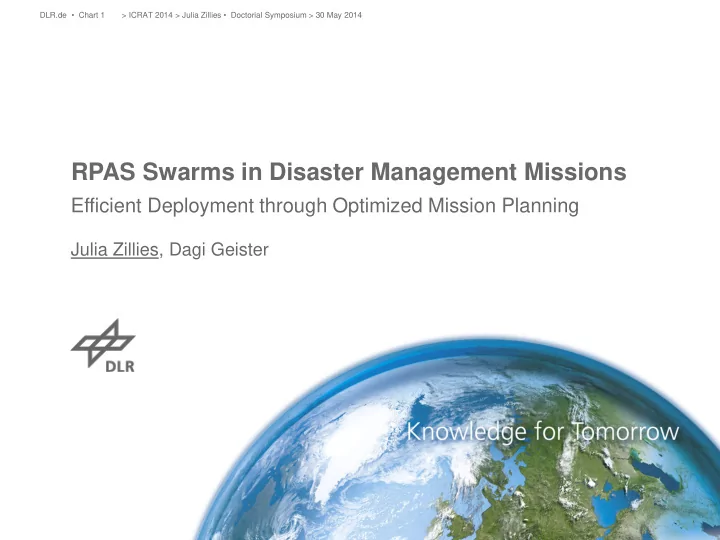

DLR.de • Chart 1 > ICRAT 2014 > Julia Zillies • Doctorial Symposium > 30 May 2014 RPAS Swarms in Disaster Management Missions Efficient Deployment through Optimized Mission Planning Julia Zillies, Dagi Geister
DLR.de • Chart 2 > ICRAT 2014 > Julia Zillies • Doctorial Symposium > 30 May 2014 Introduction RPAS Deployment in Disaster Management Missions Data collection and processing Prompt situation assessment Optimized mission planning Airborne Situation Assessment
> ICRAT 2014 > Julia Zillies • Doctorial Symposium > 30 May 2014 DLR.de • Chart 3 Background HALE/MALE Remotely Piloted Aircraft Systems (RPAS) HALE Systems: High Altitude Long MALE Systems: Medium Altitude Endurance Long Endurance RQ-4 Global Hawk HERON RQ-1/MQ- Capable to fly up to 35 hours 9 Predator without a break Has an endurance of over 27 hours Payload capacity of up to 1360 kg 1746 kg payload capacity HALE/MALE systems are capable to carry multiple sensors including electro optical, or infrared camera systems
DLR.de • Chart 4 > ICRAT 2014 > Julia Zillies • Doctorial Symposium > 30 May 2014 Introduction Examples of RPAS Use in Disaster Management Natural Disaster RQ-1/MQ-9 Predator/ Predator B RQ-4 Global Hawk − Operated over 157 hours − Hight quality images of hot spots Wildfires, Southern California (2007) − Infrared imagery − Thermal and infrared equipment − Flew 6 missions − Several Predator RPAS operated − Images on, ID (Internally Displaced from Puerto Rico Earthquake, Haiti People) Settlements − real-time full motion videos (2010) − Images of places where soldiers are to be − 24 hour a day coverage deployed [11]. − Over 20 missions in over 500 hours Damage assessment and nuclear power Earthquake and plant status - Tsunami, Japan (2011) − Synthetic Aperture Radar (SAR) − Infrared and electro optical camera systems [9].
DLR.de • Chart 5 > ICRAT 2014 > Julia Zillies • Doctorial Symposium > 30 May 2014 Working Environment Data Visualization and Mission Planning Data Processing U-Fly Research Ground Control Station Mission 3D Terrain Operation Visualization
DLR.de • Chart 6 > ICRAT 2014 > Julia Zillies • Doctorial Symposium > 30 May 2014 Methodology Swarming Unmanned Aircraft Centralized control means to disseminate all information to a central decision-maker In decentralized or hierarchical control schemes, team members can exchange directly state information and collected data
DLR.de • Chart 7 > ICRAT 2014 > Julia Zillies • Doctorial Symposium > 30 May 2014 Methodology Database Incorporation Up-to-date information Availability and quality of already collected data Coverage awareness Include pre-disaster information Sensor Footprint
DLR.de • Chart 8 > ICRAT 2014 > Julia Zillies • Doctorial Symposium > 30 May 2014 Methodology Mission Planning A general Problem Formulation Given : 𝑊 non-identical RPAS ( 𝑤 𝑙 for 𝑙 ∈ {1, … , 𝑊 } ) of limited capacity initially located at depot 𝑇 sources (for 𝑗 ∈ {1, … , 𝑇 } ), with limited resources 𝐻 targets (goal points) ( 𝑗 for 𝑗 ∈ {1, … , 𝐻 } ), with known demand and specific service time window Find : Necessary number of vehicles, their payload profile, and feasible tours of minimal travel to all targets, respecting capacity constraints on targets.
DLR.de • Chart 9 > ICRAT 2014 > Julia Zillies • Doctorial Symposium > 30 May 2014 Area Search Methodology Mission Planning Optimization Problems Task assignment Payload planning Tracking Path planning Desired Outcome 4D Trajectory Person Detection Task identification and allocation
DLR.de • Chart 10 > ICRAT 2014 > Julia Zillies • Doctorial Symposium > 30 May 2014 Methodology Mission Planning 4D Trajectory Generation Optimization Problems Task assignment Payload planning Path planning Desired Outcome 4D Trajectory How to execute a task in a most efficient way? Scan Pattern Generation
DLR.de • Chart 11 > ICRAT 2014 > Julia Zillies • Doctorial Symposium > 30 May 2014 Methodology System Architecture Set of requests known at mission planning stage Mission Planning Stage − All tasks are known a priori Mission Planning − Stochastic programming Cost Estimator Available RPA fleet approaches Task Assignment Mission Execution Stage − Deal constantly with newly arising tasks Cost Path Estimator Planning − Online optimization approaches Retasking Request at mission Mission Execution execution stage
DLR.de • Chart 12 > ICRAT 2014 > Julia Zillies • Doctorial Symposium > 30 May 2014 Methodology Formation Flight Close Formation Flight Potential to increase the operator vehicle ratio Potential to reduce fuel consumption by drag reduction Airspace integration Formation Landing Procedures UAV 1003 RQ-1 Global Hawk UAV 1002 RQ-1 Global Hawk UAV 1001 RQ-1 Global Hawk
DLR.de • Chart 13 > ICRAT 2014 > Julia Zillies • Doctorial Symposium > 30 May 2014 Summary Research Objectives Aim: Development of a set of optimization techniques for the cooperative mission planning and control of multiple RPAS. Analysis of past disastrous events Investigation of existing research and solution approaches in the field of RPAS swarming Realistic scenario design to create a test-bed for the developed solutions Mathematical formulation of identified optimization problems Development and examination of different algorithms Report of simulation results
DLR.de • Chart 14 > ICRAT 2014 > Julia Zillies • Doctorial Symposium > 30 May 2014 Thank You!
Recommend
More recommend